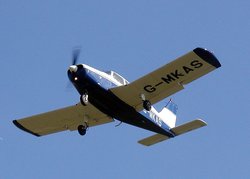Aspect ratio (wing)
|
|

In aerodynamics, the aspect ratio is an airplane's wing's span divided by its standard mean chord (SMC). It can be calculated more easily, however as span squared divided by wing area: <math>AR = {b^2 \over S}.<math>
Aspect ratio is a powerful indicator of the general performance of a wing. Wingtip vortices greatly deteriorate the performance of a wing, and by reducing the amount of wing tip area, making it skinny or pointed for instance, you reduce the amount of energy lost to this process, and increase the lift generated by the wing. This is why high performance gliders have very long, skinny wings; with no engine power, they must be as efficient as possible in every respect in order to stay aloft.
Why don't all aircraft have high aspect-ratio wings? There are two main reasons:
- Structural: the deflection along a high aspect-ratio wing tends to be much higher than for one of low aspect ratio, thus the stresses and consequent risk of fatigue failures are higher - particularly with swept-wing designs.
- Maneuverability: a high aspect-ratio wing will haver a lower roll rate than one of low aspect ratio, due to higher drag and greater moment of inertia, thus rendering them unsuitable for fighter aircraft.
It is interesting to note that as with many discoveries in science and engineering, nature got there first. Most birds have wings with a wide aspect ratio, and with tapered or elliptical tips. This is particularly noticeable on soaring birds such as the Albatross and Eagles. In addition, the V-formation (echelon) often seen in flights of geese, ducks and other migratory birds can be considered to act as a single swept wing with a very high aspect ratio - the vortices shed by the lead bird are smoothly transferred to the next and so on. This confers a huge efficiency advantage to the flight as a whole - perhaps as much as a 100% improvement compared to a single bird in flight. Note that the usual common explanation of the V-formation - that following birds are "shielded" from air resistance by the bird in front - may be misleading. While birds do "take turns" at being the lead bird, it is probably to give those at the tips a rest - they are the ones that will experience the most drag when the vortices are finally shed. However, the full explanation of this behaviour is still the subject of research and debate; scientists still do not claim to have fully understood the phenomenon.
See also
- Wetted aspect ratio
- Aspect ratio for other uses of the term "aspect ratio"
External links
- Scientific paper discussing V-formations in migratory birds (http://beheco.oupjournals.org/cgi/content/full/15/1/158)

